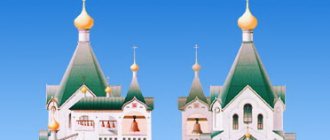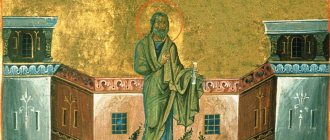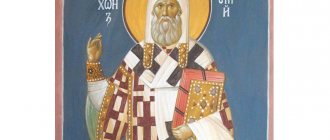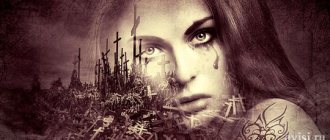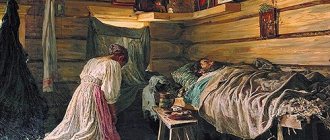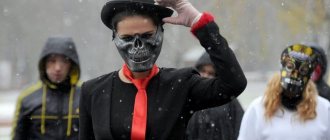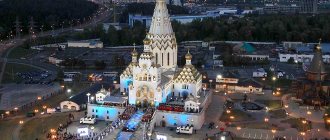| Icon of the Council of All Saints who shone in the Russian land |
Synaxis of All Saints Who Have Shined in the Russian Land
, a celebration of the Russian Orthodox Church dedicated to the memory of all Russian saints. Celebrated on the second Sunday after the Feast of Pentecost.
The idea of a cathedral celebration of the memory of Russian saints appeared in the middle of the 16th century, after the glorification of a host of Russian saints at the Moscow Councils of 1547 and 1549. The first service in honor of the “new Russian miracle workers” was composed by Gregory, a monk of the Suzdal Spaso-Evthymius Monastery, and was intended to be sung on July 17; this day became the original date for the celebration of the Council of Russian Saints. The service was copied in manuscripts [1], but was not included in printed Moscow editions of liturgical books of the 16th-17th centuries. Since the end of the 18th century, it was published by Old Believer printing houses [2]. After the 17th century, this celebration is preserved only among the Old Believers and is celebrated on the week (i.e., on Sunday) after the memory of the Prophet Elijah (July 20). The succession includes the troparion of the 3rd tone: “The most honorable mile, beloved by God, blessed fathers”, kontakion of the 8th tone, similar to “Like the first fruits”: “As preachers of piety and curbs of wickedness”, canon of the 8th tone, irmos: “Song Let us come, people,” beginning: “All the spiritual songs that have shone through fasting.” The sung stichera (slavniks) from this service are known from singing manuscripts from the 17th century. A set of slavniks (usually 6) is consistently given in manuscripts of the Pomeranian tradition (Singing Books. 2001).
Around 1643, Hierom. Meletius Sirig, protosyncellus of the Patriarch of Constantinople, at the request of Metropolitan. Peter (Mogily) wrote a service “to the venerable fathers of the Kiev-Pechersk and all the saints who shone in Little Russia,” i.e., the Ukrainian analogue of the service in honor of all Russian saints. At the end of the 1640s, following the example of the service of Rev. Meletia Solovetsky priest. Sergius (Shelonin) wrote a service “to all the saints who shone forth in Great Russia in Lent” (known from the only manuscript of the 17th century - NLR. Sol. 877/987). Despite the names, the services of hieromonks Meletius and Sergius are dedicated not only to the saints, but also to saints glorified in other guises; The names are due to the fact that both services are modeled on the service in honor of all the reverend fathers on Cheese Saturday [3]. The sequences compiled by hieromonks Meletius and Sergius did not receive much widespread use in liturgical practice.
In addition to hymnographic works, several texts were created for the services of Russian saints. Thus, the monk Gregory of Suzdal wrote a “Laudatory Word” in honor of the new miracle workers [4], Hierom. Sergius (Shelonin) - “A word of praise to the Russian saints” [5].
The modern celebration of all the saints who have shone in the Russian land was established by the decision of the Local Council of the Russian Orthodox Church in 1917-1918. At the meeting on August 7/20, a report was heard from Prof. B. A. Turaev on the celebration of the memory of all saints, new Russian wonderworkers [6]. The report gave a brief overview of the history of the service to the new Russian wonderworkers, gave examples of similar services (to the Old Testament forefathers, the monks of Athonite, etc.) and proposed to restore the celebration of the memory of Russian saints on Sunday after the memory of all the saints of the week, following the example of the memory of the Athonite ascetics celebrated on St. .Grief. After hearing the report, the Council decided to restore the celebration of the Day of Remembrance of All Russians. saints on the first Sunday of Peter's Lent, and the corresponding sequence (based on the sequence of the monk Gregory, but corrected and supplemented by the Higher Church Administration) is printed at the end of the Colored Triodion. The articles were transferred to the Editorial Department of the Council and accepted with minor amendments on August 13/26 [7]. The addition and correction of the service was entrusted to Turaev and the priest. Afanasy (Sakharov).
The service was almost completely rewritten; only a few chants remained from the old one. The initial version of the service was published as a brochure in the civil press in Moscow in 1918; The publication contained a large number of typos. Jerome. Afanasy (Sakharov) edited the service throughout his life. Its next edition was published in Moscow in 1946. The final text of the service, more complete than the text of the first editions, was released as part of the Menaia prepared by the Moscow Patriarchate in 1978-1989 [8]. The service has many features determined by the desire of the priest. Athanasius to highlight it in the circle of holidays of the Russian Orthodox Church; it includes redundant hymnographic material, which allows it to be performed in its entirety both on Sunday and on weekdays. Some features compiled by Rev. Athanasius's services are not entirely traditional: the list of names of all Russian saints at the litiya has no analogues in ancient services (and after the glorification of the host of new martyrs at the Council of Bishops in 2000, it became practically impossible), the combination of three magnifications addressed to God, the Mother of God and all Russian saints , does not find a correspondence in the Typikon.
The sequence placed in the Menaion includes the troparia of the 8th tone: “Like the red fruit of Your saving sowing” and the 4th tone: “Citizens of Jerusalem on High”; kontakion of the 3rd tone, similar to “Virgin today”: “Today is the face of the saints who pleased God in our land”; canon of Matins, 8th tone (irmos: “You plunged Pharaoh and his chariots into black”, beginning: “Let us all sing in harmony in spiritual songs”); a small prayer canon, compiled in the likeness of the prayer canon for the Mother of God in the 8th tone (irmos: “I have passed through water like dry land,” beginning: “With many adversities, we resort to you”); more than 10 samoglas, 3 cycles of similars, as well as cycles of stichera at litia, at Vespers and at the anointing of oil at the end of Matins, including similars of all voices. Proverbs of Vespers: Isa. 49:8-15, Sir. 44:1-14, Wis. 3:1-9; Gospel of Matins: Matt. 4:25-5:12; Liturgy readings: prokeimenon from Ps 15, Col. 3:20-4:3 (or Heb. 11:33-12), alleluia with verses Ps 43, Luke. 12:32-40 (or Matt. 4:25-5:12), involved Ps. 149:4; among other things, the service includes special troparia for the blessed.
The service is very popular (although, as a rule, some of its parts - prayer singing the day before, a number of chants, etc. - are in practice shortened or omitted), some of its texts (for example, stichera are similar to “Russian Land”) are among the most famous and loved ones in the Russian Church.
Troparion, tone 1
Like the red fruit of Your saving sowing,/ the Russian land brings to You, O Lord, all the saints who shone forth in that one./ By those prayers in the deep world// Keep the Church and our country with the Mother of God ́, Much merciful.
Troparion, tone 4
Citizens of Jerusalem, the Most High,/ who have risen from our earth/ and have pleased God in every rank and every feat,/ come, let us sing, faithful ones:/ O all-blessed land of Russia, intercessors, / pray to the Lord, / that He may have mercy on this from His wrath, / healing her contrition, // and she will comfort her faithful people.
Service to All Saints who have shone in the Russian Land
In May 1935, immediately after the opening of the metro, an unusual religious procession took place in Stalinist Moscow. Bishop Afanasy (Sakharov), with an icon of all Russian saints, rode the first and then only line from Sokolniki to Park of Culture, while reading prayers for the consecration of the capital’s new mode of transport. But then, this harmless act in modern times could cost him his life...
The choice of the icon was not accidental. Vladyka Athanasius was directly involved in its writing. He also spent almost thirty-five years compiling the service to All the Saints Who Shined in the Russian Land, and it is to him that we owe much of the revival of this ancient Orthodox holiday in our country.
All respected fathers who shone forth in Holy Mount Athos. Second week of Pentecost
Discussion: 33 comments
- r.B. Nikolay:
06/28/2011 at 00:00Maybe from the position of 1948 everything looked like this, but now many things are seen differently. “Great” is more and more similar to “wolf”, convened to celebrate the overthrow of the Anointed One. The turmoil and the accession of Antichrist power are a consequence not of the “vague” sins of the Russian people, but of the specific sin of the Tsar (and therefore) apostasy. It was not the Februaryists, not the Octoberists, or their descendants who repented of it. Many “new martyrs of the 20th century” “tortured in countless concentration camps” may not have understood WHAT, they were treated so “coolly”, and accordingly did NOT repent of the sin of arrogance and, accordingly, Russia is not becoming Holy Russia (which is still obvious). And in the icon of All Russian Saints there is truly a “wonderful harmony of Catholic Integrity” because The Sovereign is positioned Christocentrically under the altar and around him ALL RUSSIAN SAINTS prayed for him and remain faithful to him (even to death). And we unrepentant Tsar-fighters will continue to face the continuation of the Christ-fighting IGA until we come to the Mind of Christ and the Tsar, and we will not pray for the Tsar at every liturgy (as it was in the old days, when there was Holy Rus'). And there is no need to cry about the Taxpayer Identification Number, juvenile justice, cards and chips - they deserve everything. We need to repent and live according to the Orthodox - glorify God in the Holy Trinity and our God-given Kings from St. John to St. Nicholas!
- R.B.Alexander:
07/01/2011 at 00:00
And to this day the priests tremble at the mere mention of the Name of the Tsar, slander the Russian Tsars (and therefore Holy Rus') and glorify their priestly democracy - false patriarchy. Struck by the Latin heresy of papism, having forgotten the Russian Testament (1613), the priests arbitrarily and without permission (by betraying the Tsar) appropriated power to themselves. Through false patriarchy, i.e. the patriarchate instead of and against the Tsar, dreamed of dominating the inheritance of God. But no one can take anything from the Lord without permission. Having arrogated Royal rights to themselves, the priests could not (and will not be able to) fulfill a single Royal duty: to stand guard over the purity of the Orthodox Faith; to be a shield and fence of the Holy Orthodox Church, God's Chosen Russian People and our Fatherland - Holy Rus'. They betrayed the Tsar and lost Holy Rus'. And now we are sitting at a broken trough and staring blankly, but we don’t want to understand anything (and we can’t): we had the Holy Orthodox Faith, which firmly stood and stands on the rock of the dogma of the Royal Power of the Anointed of God, and now a heresy that has absorbed all heresies — ecumenism; they had the Anointed of God, Christ of the Lord - the King, and now a false patriarch who arbitrarily wants to be instead of the Tsar (this desire is indicated by his stolen Royal Title - Great Master and Father); they had a Christ-loving, Orthodox Royal Army, and now they have mad dogs - cops. There is nothing to say about the “authorities” at all, i.e. we have anti-government and anti-state with all the ensuing consequences. But the priests are quite satisfied with both this power and “its army” and they “pray” intensely for them. But we just can’t find ourselves. Blind and deaf, dumb and lepers, paralyzed and having forgotten their Father-Tsar and Mother-Church, maddened to the point of neo-paganism... These are the results of your freedom from the Autocratic Tsar, my poor Rus', and what we, the small flock, can say: heavy is the right hand Thy Lord, but Thy Holy Will be done. Your rod and your club, O Lord, will comfort us. Take courage Rus' and may your Orthodox Heart be strengthened and be patient with the Lord! And remember firmly, Holy Rus', the Lord shepherds us and will deprive us of nothing... Lord, gather us on our land and grant us repentance before the end! The king is coming! For Faith, Tsar and Fatherland!
- Oleg (Little Russia, Ekaterinoslav):
06/19/2012 at 00:00
“between the end of Holy Rus' and ....” But Holy Rus' never existed. They built it, they fought for it, it is in the aspirations of the Russian people. It will exist in the future, when there will be the kingdom of Antichrist and the Russian kingdom.
- R.B.Anatoly:
07/08/2013 at 00:00
R.B. Nikolai said very precisely: how important it is to understand WHAT the Lord punishes. Alas, many understand this already beyond the boundaries of earthly existence. And the multi-figured icon of All Saints is amazing in its execution.
- Russian Orthodox monarchist:
06/22/2014 at 00:00
I also agree with R.B. Nikolai, since February 17th everything reminds me that the slaves killed the owner, his descendants were kicked out and whoever was the most insolent among the slaves seized: one barn, the other the owner’s estate with a house (on the estate plot and oil and gas) and now they are fighting among themselves. And during their fights, sheep and chickens and other smaller slaves get hit (who are beaten to death). Nearby there are “good” neighbors who do not forget to “add fuel to the fire” of the war between slaves, so that there are fewer of them left and then they themselves take the barns, and barns, and fields, and houses, and cattle, and oil, and gas , and other slaves who will work for them. And the “kindest” neighbors will help them by participating in their fights on opposite sides at the same time (some with weapons, sometimes with provocations, and sometimes by personally killing slaves). And they will put in their minds about the defense of the Fatherland, birch trees, gilded baths, and the great leader and golden shoulder straps for officers, as before, and they will remember the ancients about the commanders (without mentioning that the graves of relatives and commanders were plundered by slaves and destroyed by them). And about the greatness of their Fatherland, etc.
- Let's be sad:
07/03/2016 at 00:00
Well well. Where did you get the idea that the end of Holy Rus' was at the turn of 1917? This is a long process, which was started by Patriarch Nikon with his church reform and the beginning of the schism. I would probably even determine that the beginning of this process is associated with the extinction of the Grozny (Rurikovich) dynasty. Then there was turmoil and the beginning of the Romanov dynasty, many of whose representatives were, to put it mildly, not up to par. The whole process began with the heresy of the Judaizers. However, the Grand Dukes Ivan III and Vasily III managed to cope with it, although at first they took the side of its apologists. Ivan IV the Terrible completed its defeat, but, unfortunately, not complete destruction. For this, many then and present historians, including MVN, terribly dislike him, covering up this dislike with the horrors he allegedly created. But the new tsars from the Romanov family failed to rise to the occasion, and completed what the heresy of the Judaizers stood for - they did split the Russian Church. 1917 - this is the logical conclusion of the process of the collapse of Holy Rus'.
- MVN:
07/03/2016 at 00:00
Anonymous. Well, what are you itching for? You, of course, have the right to make accusations. But the Orthodox are supposed to express them in their full name and prove them with facts. You are afraid to give your name, but at least I ask you to prove that I deny the holiness of Grozny precisely for the defeat of the heresy of the Judaizers. And at the same time, what was this defeat of him? Which of the thousands of his victims (mostly noble families) was a Judaizer? M.b., in your opinion, the then exiled first hierarch, who denounced his extrajudicial reprisals against entire families with small children?
- Let's be sad:
07/03/2016 at 00:00
Don't exaggerate, MV. I didn’t blame you for not loving Grozny for the heresy of the Judaizers. I listened to your speeches on this matter and I know that you do not like him precisely because of the murders he committed. But, for example, Grozny’s murder of his son, at a minimum, has not been proven. Many murders have also not been proven, or even attributed to him. The chronicles could have been written or later edited by haters of Ivan the Terrible. They don't have complete trust. Judge them according to their deeds. But the fact was that we once had an autocratic Orthodox kingdom in symphony with the Church, or as this phenomenon was later called Orthodoxy-autocracy-nationality - entirely his merit. Ivan the Terrible was the first Holder in a long line of subsequent sovereigns, successful and not so successful. And regarding the defeat of heresy and its apologists, read academic works on this matter. The names are given there. And dates. And the facts. Naturally, with some conjecture, it was still a long time ago. Well, with regard to the murders of thousands of families, everything is also presumptive. Moreover, do not measure the morals of that time by today's standards. The murder then and the murder now are different. And even now they strive to kill more spiritually than physically, which doesn’t seem so scary and there is no such indignation. Remember - And do not be afraid of those who kill the body, but cannot kill the soul; but fear more than that, who can destroy both soul and body in Gehenna. There is only one fact - the existence of Holy Rus'. And the credit goes to Grozny for its development.
- MVN - To the sad anonymous person:
07/03/2016 at 00:00
Your Majesty. I am not exaggerating, but in exact accordance with your words, I asked for an answer and for compliance with Orthodox rules. You don't want to do this. In this case, I advise you not to act as an Orthodox teacher on this site. Especially if you think that the murder of children during the time of Ivan the Terrible is excusable for the “detainer”. You, our incomparable historian-ideologist, have you at least looked into the Synodik of Grozny, who and how many of his guardsmen “finished off”?
- Let's be sad:
07/04/2016 at 00:00
Why should I teach you poor Orthodoxy? This is the time to teach sanity. Who wrote the Synodic of Grozny? Was it really, God forgive me, a sinner, that the Lord himself wrote? No, people, but they have passions. Well, for example, like you. Child murder is a terrible sin, I don’t argue. However, I’m now reading some academic work, and the Terrible killed my father, but not my wife and children (fact!). Once again, the synodics could have been falsified, because it was a long time ago and there was time, and they were malicious. Someone once started a rumor about Grozny’s murder of his son, and Repin even drew a picture to this effect. But the murder has not been proven by anything. But Vasnetsov painted a completely different Grozny, go take a look in real life, it’s closer to you. There is Repin and his ilk, and there is Vasnetsov and his people. Who are you with?
ZY I am not an apologist for the holiness of Ivan the Terrible; let the Lord judge him and reveal him to us. But the formation of the Holy Russian Kingdom is his merit.
- MVN - anonymous:
07/04/2016 at 00:00
“the establishment of the Holy Russian Kingdom is his merit”... And I thought that this was the merit of the Russian Church and the host of its saints, who did not kill children and thousands of their compatriots and did not get married five to seven times.
- Konstantin:
07/05/2016 at 00:00
But what interests me most is something else, although it is directly related to the topic. Russia always received God's punishment for its retreat, both for Ivan the Terrible and for the betrayal of the Emperor... In the 90s, monstrous crimes were committed, the plunder of the state, the destruction of industry, the death of at least hundreds of thousands of people. Will this system go unpunished? Will billionaires rule the roost forever, and the history of Russia—real Russia—will be over? Will God's punishment never befall them, and why then was there all this majestic, tragic history of ours? A question of questions.
- Petr Ivanov:
06/16/2017 at 00:00
The life-giving words of this article: “...on the second Sunday, with a separate holiday, we remember all the Saints of Russia, our Saints who are closest to us. This is one example of the fact that national patriotism in Orthodoxy is not canceled out by a higher value, as liberals like to tell us, but remains an undoubted and important step in the hierarchy of values, which needs respect and protection.”! Low bow for such lines..!
- Petr Ivanov:
06/16/2017 at 00:00
To Konstantin (from 016-07-05): Your (rhetorical?) “Question of questions” may not arise for many due to the CONFIDENCE of the soul that at the Judgment of God everyone will answer in full for their earthly deeds - known and unknown. It is this CONFIDENCE that allows you to continue to live in the most unbearable conditions and carry your Cross of life.
- Justina - MVN:
06/17/2017 at 00:00
With all due respect to you, the attitude towards the holy, locally revered Tsar Ivan Vasilyevich (whose images are present in the painting of the Assumption Cathedral in the Kremlin) is somewhat jarring. If there had been no Tsar, there would have been no formation of the Russian Kingdom. And the Church itself would not have done anything. Just like at the present time, with the presence of the Church and the absence of the Tsar, we see what a disastrous situation the state is in. And how the Holy Synod rejoiced at the beginning of “free life” without the shackles of tyrannical tsarism. We are still reaping the benefits of this “freedom.” Isn’t it obvious that the Russian Monarchs, the Anointed of God, correlated all their decisions and actions in governing the country entrusted to God with the Law of God and were a church fence. It is a thankless task to contrast the priesthood and the kingdom. How to contrast the two natures of the Savior - Divine and human.
- MVN:
06/17/2017 at 00:00
Dear Sister Justina. I respect everything that Tsar John did that was useful for the Russian state: https://rusidea.org/25033101. But why do you have to proclaim him a saint? There are many church obstacles to this, and the Church has never considered him a saint. See: https://rusidea.org/32034
- Alba - MVN:
06/17/2017 at 00:00
The Judaizing hierarchs of the Church may not have considered Him a saint, but the Orthodox people with the Heavenly Head of the Church Christ glorified the first Russian Tsar Ivan the Terrible for centuries. See: https://3rm.info/publications/59847-falsifikatory-i-falsifikacii-istorii-car-ioann-groznyy-i-mason-karamzin.html
- MVN - Alba:
06/17/2017 at 00:00
Dear Alba, indiscriminately insulting all the hierarchs of the Russian Church of the 16th-20th centuries. for disagreeing with you, you, together with your sinless prophetic site (if you believe it, then the end of the world should have already come many times over), blaspheme our Church and those holy martyrs (Metropolitan Philip, St. Cornelius, etc.) who were truly glorified. And if you lack an elementary moral sense, then at least do not attribute your zeal not according to reason to the entire Orthodox people, and especially to Christ.
- Nadezhda to Alba and Justina:
06/18/2017 at 00:00
The said article on 3rm.info cites the opinions of historians about the merits of Ivan the Terrible as a ruler - and MVN does not argue with this. But this is not enough to be recognized as a saint, and these historians did not declare him as such, especially since this was not within their competence. Only the Church has the right to canonize someone, and in this case none of the zealots can bring such documents, because they do not exist. The frescoes of the Kremlin Cathedral are not proof, because... in Rus', following the Byzantine tradition, all baptized Grand Dukes were depicted with halos, incl. not saints (see the recommended detailed article by priest Mikhail Nemnonov: https://rusidea.org/32034)
- MVN-Justina:
06/18/2017 at 00:00
Dear Mikhail Viktorovich, regarding Metropolitan Philip and Venerable Cornelius - dirty lies and slander. Historical research, including Met. Ioann (Sychev) proved the complete inconsistency of the Masonic versions of Ioann Vasilyevich’s involvement in their death. There is a saying about the site about not throwing out the baby with the bathwater. No one insults the hierarchs indiscriminately, but only the Judaizers. Would you mind citing as an example the names of the hierarchs of the Holy Synod who did not betray the Sovereign and did not swear allegiance to the Masonic Provisional Government? Thank you in advance.
- Alba - MVN:
06/18/2017 at 00:00
Never could I have imagined it before! That, reading your published scientific works on the History of Russia, thanks to which for the first time in a new way the divine meaning of such concepts as the Orthodox Monarchy and Autocracy, the features of the Symphony of the Royal and Spiritual Powers, the features of the Succession to the Throne in Rus' was revealed to me, I am jumping to the point of “a sweeping insult of all hierarchs of the Russian Church..." with "lack of elementary moral sense...". However, the only consolation is that even before this “fall” he managed to sign the “Letter of 5000”, then remain in prayer protection on Basmannaya. And in 2007, to speak out in defense of K. Dushenov from persecution by the prosecutor’s office of St. Petersburg and receive from them an “affectionate” permanent “black mark”. But forgive me, an unreasonable sinner. But weren’t Abbot Joseph of Volotsky and Archbishop Gennady of Novgorod fighting against the Judaizing clergy? Didn’t the Russian Orthodox people prayerfully call for Sovereign John Vasilyevich to return to the Tsar’s Throne? And it was not Metropolitan John (Snychev) who said that “the decisive influence on the formation of the Russo-hating beliefs of “historical science” was the testimony of foreigners.” “Starting with Karamzin, Russian historians reproduced in their writings all the abomination and dirt that foreign “guests” (Staden, Possevin, etc.) poured on Russia. And the result is that now the leaders of the Russian Orthodox Church MP are not Judaizers?! And your “quiet” head of the ROCOR, who is he?
- MVN to admirers of the unholy “saint”:
06/18/2017 at 00:00
Dear opponents. You, of course, are great experts in history, because it’s only in cooking or gardening that you need to have special knowledge, and in history and in the Church (especially in matters of heresies and holiness) there are enough zealous cries about “karamzyatina” - which you find long before Karamzin even in the monastery chronicles: they say, everything is “dirty lies and slander.” Did Karamzin write them? Did Karamzin also write the Tsar’s synodikum with the names of exterminated families along with their children? Did Karamzin impose church penance for polygamy on the Tsar? You are operating in the name of St. Joseph of Volotsky, but his famous instruction about the attitude towards the Tsar, who serves his own lusts, is not a decree for you - in this case, you and St. Joseph should be registered as a “Judaizer”...
If only you yourself personally professed this belief in holiness, without imposing it in an offensive tone on everyone else and without trampling those who disagree into “abomination and dirt”, I would have no complaints against you. But you, infallible anonymous judges of everyone and everything, attack the Church and Russian historiography, casting the sins of the Februaryist bishops into the distant past, and from there stretching the heresy of the Judaizers even onto the ROCOR - in the style of: “Glory to Thee, God, that we are not like them !”, while out of pious modesty concealing your glorious full names and academic theological titles that give you the right to judge.
Unfortunately, it is impossible to convince you in this position, because... Instead of responding to the essence of the objections being made to you and at least looking at the links offered to you in materials containing indisputable facts, you are only capable of monotonous hysterical screams.
What is there to argue about if you cannot name a single pre-revolutionary historian who would consider the Terrible Tsar a saint, you cannot cite a single church decision on his glorification. (Your favorite authority, M. John Snychev, was neither a researcher nor a historian, and Konstantin Yuryevich, who wrote books for him, has now gone so far as to blaspheme the real holy Sovereign Martyr, placing him lower than Stalin and Putin.)
There is no point in continuing the discussion in this style, especially since you are not adding anything new to what has already been said and discussed many times, incl. in a debate with all your authorities on the forum:
- Hope:
06/19/2017 at 00:00
Dushenov already has Stalin as a saint and Putin will soon become one too. I wonder, Justina and Albina, how do you feel about Stalin?
- Let's be sad:
06/19/2017 at 00:00
After the MVN attacks on Grozny, I sat down and read a bunch of literature about it. Both for and against. By the way, I haven’t read Snychev, because I’m a Sergievite. My conclusion is that if I voted for the sanctity of Grozny, I would vote FOR. And the position of the MVN seems very strange to me. And in many ways it resembles the position of the “Orthodox” priest Alexander Men, whom Metropolitan Anthony (Melnikov) called the guard of Zionism in Orthodoxy. This is how I see the role of the MVN as a guard. Of course, not Zionism, everything is more vague here. And maybe not so consciously. But no less destructive, alas. May Christ give you the strength to change your mind, MV. Or rather, conceit. You have time.
- Nadezhda - Despondent:
06/19/2017 at 00:00
You are demonstrating again and again that you are not able to respond to the specific arguments and facts of the MVN (as well as Father Mikhail Nemnonov, chronicles and all Russian historians). Judging by comparison with the “Zionist guard”, you are not very smart at all. Truth is determined not by “heaps of literature”, but by its quality. And besides, anonymous names are not acceptable in “voting” among Orthodox Christians.
- Justina - Nadezhda. :
06/19/2017 at 00:00
Do not confuse God's gift with scrambled eggs, comparing the Anointed of God Ioann Vasilyevich with the head of the atheistic USSR.
- Nadezhda to Justina:
06/19/2017 at 00:00
Why is this edification of yours addressed to me, and not to your admirers of both Grozny and Stalin (like Dushenov, Erchak and many similar zealots)? And in this regard, I wonder why it is impossible for people like you to be taught elementary logic in discussion?
- MVN - Nadezhda:
06/19/2017 at 00:00
Therefore, due to different attitudes towards logic, I ask you to end here the fruitless debate on the issue of holiness. Everyone will receive according to their faith.
- Nadezhda:
06/19/2017 at 00:00
From Alba for Hope!!! Regarding the “anonymity” of the speakers here on the site, I’ll show you the reason why I personally had to change my real name to the pseudonym “Alba”. You probably noticed your name “Nadezhda”. So, the website of the respected Mikhail Vladimirovich is under the watchful eye of the relevant intelligence services. And when the “observer” from the “office” becomes “bored,” he, under the name of any commentator speaking here, can express opinions that are completely diametrically opposed to his, thereby discrediting the chosen “victim.” At one time I turned out to be such a victim. Why, having registered on the site under your own name, you can then perform under any other name - it’s unclear! Yes, of course, the moderator checks the content of comments, but, as practice has shown, a well-made “setup” is missed.
- Despondent - Nadezhda:
06/19/2017 at 00:00
The question is not about arguments and facts. The question is in the original position. If only there was a position and there would be arguments, because they are endless. But not everyone knows how to distinguish the wheat from the chaff. The MVN’s position is to blame Grozny, and he sees the Synodik from this side. But my position is different and I see the same synodik from the opposite side. The result is the same facts, different attitudes. Fr. you mentioned. Mikhail Nemnonov is a Sergievite, well, what can we talk about here. Once he repents of his heresy, we’ll hear about Ivan the Terrible. Ivan the Terrible, no matter how you approach him, was still not a heretic, and the canon to Michael the Archangel the Terrible governor, composed by Ivan the Terrible, is still read even in St. Sergius churches. Why are they so upset?
- MVN to opponents with violations of logic:
06/19/2017 at 00:00
I am addressing you here for the last time. Albe. You are not writing the truth, the authors of comments are not registered with us, access is free - and you can clearly see this. “Diametrically opposed opinions” are not deleted if they are made without dirty language and deliberate slander. Anyone can write on any behalf, but only honest Orthodox Christians, according to Orthodox rules, write on their own behalf, especially denouncing other people, because they are ready to answer to them for their words
.
Those who are not ready or are afraid of the special services should not write, so as not to look like an irresponsible, anonymous coward. I'm despondent. My position was initially stated both in these comments and in all materials about Sovereign Ivan the Terrible: I call for separating his merits from his sins, instead of indiscriminately covering them up with self-made “holiness”
.
If you have a “different” attitude towards the facts of violations of church commandments (including the murders of entire families with children, as indicated in the synod), then we have a different understanding of Orthodoxy
and
a different conscience
. It is also different for you from the conscience of St. Metropolitan Philip, who denounced Ivan the Terrible for these massacres. You can continue the discussion about the Terrible Tsar on the specified forum, but first you should read it in full so as not to look insane and not break into an open door. - To opponents:
06/20/2017 at 00:00
You were told that the discussion about the holiness of Tsar John IV under the article about this holiday will no longer continue, because... this is off topic. — Adm.
- Petr Pavlovich Ivanov Munich:
06/10/2018 at 16:50
It seems that behind the comments - “UNYNIM”, “JUSTINA”, “ALBA” - workers of the Moscow Patriarchate are hiding: just to distract from the material of the article and slander the site “Russian Idea”. These frantic supporters of Ivan the Terrible are afraid to reveal their names, but what are their gray opinions compared to those bold publications of the Russian Idea website itself?! Many healthy and honest readers have noticed that on all official websites of the Moscow Patriarchate (hereinafter referred to as the MP) or those dependent on the MP, at some point the opportunity to write comments completely disappeared - read and remain silent even if you see lies and deception before your eyes. Personally, I am happy that the “Russian Idea” website exists - God help the dedicated employees and authors of this God-pleasing site!
Day of All Saints who have shone in the Russian Land
The Church celebrates this holiday every year on the second Sunday after the Holy Trinity. So, for example, in 2021 the memory of all the saints in the Russian Land who have shone forth is celebrated on July 4th.
Initially, the holiday appeared in the church calendar back in the 16th century, when, at the instigation of the famous Metropolitan Macarius, the canonization of many Russian saints took place. However, then the tradition of the celebration did not take root - the Time of Troubles and the reforms of Patriarch Nikon (Dmitry Volodikhin wrote about Patriarch Nikon in Thomas) led to a break in the Russian church tradition, and the holiday was never fixed in the calendar.
The Local Council of 1917-18 tried to correct the situation. In an era of new civil unrest, the prayerful help of the saints of the Russian land was more useful than ever. The council decided to restore the day of all Russian saints in the church calendar, and Bishop Afanasy (Sakharov) began to work on compiling a new service.
He partly used old texts from the 16th century, but as a result only a few chants were taken from them. To a large extent, the service was written by Bishop Athanasius virtually from scratch.
Work proceeded slowly, which was due to external circumstances. Bishop Athanasius went through years of prison and exile; during the 33 years of his episcopate, he, in his own words: “was in diocesan service for 33 months; at large, out of work - 32 months, in exile - 76 months, in prison and in bitter labor - 254 months...” Bishop Afanasy finished work on the text of the service to the Russian saints only in 1953. After that, until his death in 1962, he edited and supplemented it.
The service, edited and supplemented by Bishop Athanasius, was first published in the May Menaion (a collection of services to the saints) in 1987. Later, it was also improved, but only slightly: for example, new names were added to the text of the service. And in 2000, its author became its “addressee”: Bishop Athanasius was glorified among the new martyrs and confessors of Russia, which means he joined the Council of all the saints who have shone in the Russian land.
Service to all the saints who have shone in the Russian Land
The full text of the service to all the saints who have shone in the Russian Land is available here
The text compiled by Bishop Athanasius is an amazing “verbal icon” of the persecuted Russian Church of the twentieth century. In the stichera on Lithia, the persecuted earthly Church asks the Russian saints to pray to God for the suffering Motherland and the Orthodox Christians who now live as persecuted and naked captives in a foreign land:
Voice 5. Similar to: Rejoice: Come, our heavenly representatives, to us, / who demand your merciful visit, / and deliver those embittered by the tormenting reproaches / and the fierce fury of the infidels, / from lower, like captives and Nazis, drive us away, / from the place to the place is often transitory/ and misleading in dens and mountains./ Be generous to us, O praisers,/ and grant us relief,/ quench the storm,/ and quench even the indignation against us,/ praying to God,/ giving I have great mercy upon you from our land.
At the end of Great Vespers, you can hear the stichera, stunning in beauty and meaning, written by Metropolitan Sergius (Stragorodsky) and the author of the 16th century service to the Russian saint, monk Gregory.
The texts of the service mention only a small part of Russian saints, since just listing the names of Russian ascetics can take several hours, as can be seen by opening the synodikon of Russian saints (text of the synodikon according to the 2006 version of the website pravoslavie.ru), which is read on this day in some Orthodox churches.
Icon of all Russian saints nun Juliania (Sokolova)
“All the saints who shone in the Russian land.” Icon. 1934 (Trinity Cathedral of the Trinity-Sergius Lavra)
Maria Nikolaevna Sokolova (in the monastic name Juliana) began painting the icon “The Council of All Saints Who Have Shined in the Russian Land” in the 1930s with the blessing of the priestly confessor Athanasius (Sakharov). For each saint who appeared on the image, the icon painter searched for information from lives and other sources in order to find an exact likeness of the iconographic image.
Bishop Athanasius described in detail the design of this icon. It depicts Kyiv and Moscow. The first city is like the foundation of Russian Orthodoxy, and the second is like its core. The icon also depicts the Assumption Cathedral of the Moscow Kremlin as the main shrine, three icons of the Mother of God associated with Russia - the Vladimir, Kazan and Novgorod “Sign”, as well as many saints.
The image, painted by nun Juliania in 1934, is kept in the sacristy of the Trinity-Sergius Lavra. Of course, it was physically impossible to depict all the Russian saints on it (even without taking into account the new martyrs), and before us is more an image of holiness than a literal image of all Russian saints.
List of saints
This is a list of glorified Great Christian saints, divided by holiness: Prophets, Apostles, Saints, Martyrs, Reverends. First on the list are the glorified saints with the prefix “Great”. But also the most revered, in several Christian denominations (both in Eastern Christianity and Western Christianity), saints are equal in veneration to the Great Saints.
This list can be used to develop articles: Christianity and Orthodoxy, as well as to create new articles on this topic, for example, such as: Great biblical prophets, Great Christian saints.
A complete list of all saints can be viewed at this link https://ru.wikipedia.org/wiki/List_of_great_Christian_saints

